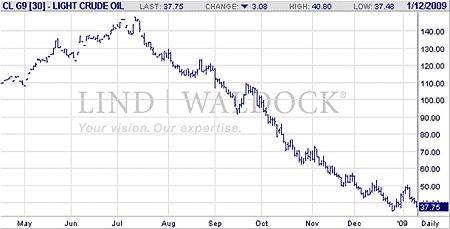
With commodities having kicked off the New Year brightly, it looked like we were going to see an end to the selling downward pressure in the markets. But alas, as this column takes its first look at the commodities world in 2009, we do so just as another slew of selling takes place in the dozen or so commodities that we track.
As always, we start this week’s analysis with the most eternally popular commodity story: Oil…
$10 To $15 swings in the oil market
Describing the state of the oil market at the moment requires just two words: unprecedented volatility.
Over the course of each week, we continue to see the price whipsaw back and forth with $10 to $15 per barrel ranges. For example, having hit a low of $33 a barrel near the end of December, oil climbed back up to the $50 level last week, and is currently trading near $38 a barrel as I write (so it could be entirely different by the time you read this!)
Predicting the next move for this market with any kind of confidence is a tough call at the moment. But that’s what I get paid to do, so I’m sticking with my belief that the path of least resistance for now is down.
Demand down; supplies up = lower prices
The current decline comes amid the feeling that oil consumption will continue to fall by as much as one million barrels per day, according to Deutsche Bank. And even OPEC’s recent 9% production cut might not be enough to beef up prices, as the global recession squashes demand. If the current downtrend continues, the cartel may well cut production again at its next meeting on 15 March. At the end of last week, Saudi Arabian Oil Co, the world’s biggest state-owned oil firm, said it will lower its crude supplies to refiners by 10% in February – the third straight month it’s done so.
Many analysts are still calling for $25 oil and in a research note last week, Goldman Sachs said that “weak underlying economic fundamentals” will continue to weigh heavily on the oil market – and drag the price down to $30 during this quarter.
In addition to the above, the recent US inventory numbers are also holding oil prices lower. In the week ending 2 January, the Energy Information Agency reported that US supplies rose by almost 6.7 million barrels to 325.4 million barrels. It was the 13th gain in the past 15 weeks and is the highest number since May.
This week should bring just as much movement as the previous reports have done.
Natural gas
The natural gas market has also seen some volatility of its own over the past two weeks. We’re still looking for natural gas futures to get down to their longer-term support area, which is at the $5.000 per MMBtu level.
Near the end of December, the front-month futures contract hit a low of $5.245 per MMBtu and then bounced back above $6.200 per MMBtu. And just like the rest of the markets today, the futures have dipped back under $5.600 per MMBtu. We still have our sights on the $5 level, and we may get to see it soon if the overall selling continues.
Metals take a surprise beating
Even the usually resilient precious metals, which had made nice inroads into bullish territory since the New Year, had a tough time today. Gold futures were down more than $30 an ounce, while silver declined by about $0.70 an ounce.
We still maintain that the metals should be good bullish plays for this year. And since being knocked down off their summer highs, the speculative bull fever should be out of this market by now, giving way to easier upside moves. But be prepared to see volatile intraday moves along with the rest of the other commodity sectors.
It also seems that the fallout from the stock markets and the uneasiness over the general health of the US economy is going to keep players on the sidelines from time to time. This can cause markets to fall quicker than normal and allowing gold and silver to see large intraday moves like they did today.
South American dry patch should solidify soybeans
The US government released its monthly supply and demand figures for the grain markets this morning – and gave us a large bearish surprise. All three futures markets – corn, wheat and soybeans – traded ‘limit-down‘ today. Corn has a 30-cent limit, wheat has a 60-cent limit and soybeans have a 70-cent limit.
The grains had also made solid bullish moves since the beginning of December, and looked like they’d found their bottoms. Soybeans had rallied close to $3 a bushel off their lows, while corn and wheat rallied by $1.25 a bushel and $1.70 a bushel respectively. Those are solid moves, but they were getting into overbought territory – and the reports out today gave traders a really good excuse to take profits on the recent runups. Each market may have a little bit more to go on the downside in terms of working off the recent bull move – but not too far.
There’s talk of some dryness in South America – the second-biggest producer of soybeans behind the US. This should keep a floor under the soybeans. Any weather disruption, whether it’s here in the US or in South America, can always ignite another bull run, which in turn will help the other markets (corn and wheat) to stabilise.
That’s all for this edition.
• This article was written by Lee Lowell, futures options & commodities specialist, for the Smart Profits Report, and was first published on 12 January 2009.